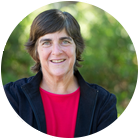A new addition to the SEQ, Pars pro Toto
Dear SoE graduate students,

Those of you who have visited the Science & Engineering Quad over the past several weeks have undoubtedly noticed a marked change in the environment. Not only are there more students, faculty, and staff working and studying on site as the conditions around the pandemic have improved, but recently we installed an outdoor art piece, Pars pro Toto, that you can’t have missed.
Created by the Polish-German artist Alicja Kwade, the piece consists of 12 stone spheres, ranging from 16" to 98" in diameter, and from 200 pounds to 23 tons in weight. The work is made of 12 different kinds of stones from eight countries on three continents. You can learn much more about the project here. (And if you like, you can download some Zoom backdrops with it here).
I’ve visited campus several times over the past few weeks, and each time I’ve been delighted to see how the art interacts with the SEQ spaces -- and how the people coming through each have their own way of interacting with the art. Many are compelled to run their palm over the sculpture’s smooth and polished surfaces. Others take selfies with it. Still others stand or sit quietly in the shadows cast by the largest of the stones.
One of the reasons I’m so pleased to see this engagement is because I know just how much effort went into bringing to campus a new piece of art that not only fits in with our culture and sense of community, but also contributes to it in a meaningful way.
Our process for selecting the work started by pulling together a diverse committee of incredibly thoughtful students, faculty, and staff, who collected community feedback about what kind of art would be most welcome in the SEQ. To help guide them in the process, the committee sent a survey to students in many of our student organizations, asking them to tell us what words and ideas they most associated with the SEQ. Committee members also conducted in-person interviews; in total they heard from more than 50 students.
The student feedback was diverse, and fascinating. Some of the key terms that emerged were innovation, openness, light, and cutting-edge technology and ideas. However, students also shared that they associated the SEQ with words like empty, traumatic, suffering, and stress. One student said the SEQ should feature art that highlights the links between science and engineering and society at large. Too often, the student said, science and engineering are seen as removed from the immediate needs of people, yet improving lives is in fact the ultimate goal. The art piece should remind those of us who work and study in the SEQ why we do what we do.
I hope you will find that this feedback is reflected, even in an abstract way, in the committee’s selection and in the work itself. Personally, each time I visit the piece I find a new layer of engagement with it. Of course, each of you will bring to the piece your own interpretation, and your own way of looking at things. And as we slowly come back to campus, I look forward to seeing you all do so.
Jennifer Widom




